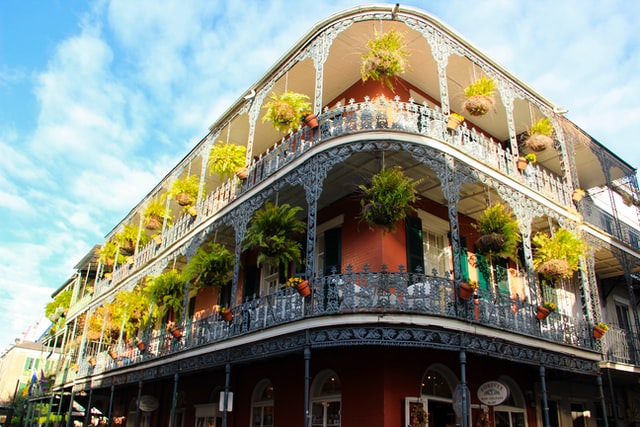Slowing Down in NOLA: Exploring the St. Charles Streetcar Route

The clackety-clank of New Orleans’ olive green streetcar is poetry in motion, trudging along St. Charles Avenue, then screeching to a halt along finely woven cables overhead. Suddenly I’d escaped from the rowdy French Quarter and discovered the Garden District’s gentle romance. The St. Charles Avenue streetcars offer six miles of iconic Southern US architecture on a cable-tethered route, with mahogany railed seats that jolt and shudder with every movement of the tram. First opened in 1835, the St. Charles line is the oldest continuously operating streetcar system in the world, and listed on the National Register of Historic Places.
Riding the green line is a favorite pastime of mine when I’m visiting the Big Easy; it’s a scenic riding tour and could well be the cheapest entertainment in town. I arrived in New Orleans late afternoon, checked into my hotel for the weekend and was ready to get out into the city. After a day of driving, the streetcar is always a welcomed slower pace. I boarded at Canal Street, using my Jazzy Pass for unlimited boarding and transfers. No matter how many times I’ve does this tour, there is always a surprise. This trip was no exception.
Within minutes, we arrive at Lee Circle, where tourists disembark to walk a few blocks to the National WWII Museum, the Confederate Memorial Hall Museum, or the park surrounding the memorial statue of General Robert E. Lee. Just beyond the Central Business District and Lee Circle, the streetcar goes under the I-10 Freeway (US Highway 90). This leads to the Garden District, home to stately southern mansions, wicker chairs rocking on wrap-around porches, and century-old trees with their draping lacy gray Spanish moss.
Slowing Down in NOLA: Exploring the St. Charles Streetcar Route.
At this point, I began my walking tour. Exiting the trolley at St. Andrews, I walked to the New Orleans Convention and Visitors Bureau, my favorite place for learning about local events for the weekend. The staff is consistently knowledgeable and willing to share generously. My surprise on this trip was finding a remnant of the Eiffel Tower on a busy street in New Orleans. There are delicate slices of France all over New Orleans, but the Eiffel Society building is quite a treasure.
This building, with its cold steel structure and tall glass walls, was constructed from 11,062 pieces of a Paris restaurant at the Eiffel Tower in France. Transported to New Orleans in the 1980s, this iconic social club stands alone in its modernity among the stately columned homes. Just across the street, the Hot Tin Bar provides panoramic views from the top floor of the Pontchartrain Hotel.
Back on board the streetcar, traveling towards Carrollton, shimmering plastic beads dangle from the trees along the Mardi Gras parade route. The Washington Street stop is the exit point for visiting the Garden District Book Shop, Commander’s Palace Restaurant and Lafayette Cemetery #1. Continuing by streetcar, I notice collegiate flags fluttering against the light poles. We’ve reached Loyola University and Tulane University (side by side) along with Audubon Park, Audubon Zoo, and Audubon’s Butterfly Park.
Slowing Down in NOLA: Exploring the St. Charles Streetcar Route.
After a stormy day, the looming clouds gave way to white fluffs and a cerulean blue sky, creating a postcard-perfect view of the stately Loyola campus buildings. Loyola University was founded in 1904 as Loyola College, moving to university designation in 1912. The institution carries the name of the Jesuit patron, Saint Ignatius of Loyola. I walked the manicured grounds, enjoyed the architecture and statues, and headed across the streetcar tracks to Audubon Park. This is a lasting reminder of the 1884 World’s Fair, which celebrated the booming cotton business in the Southern United States. The exposition space covered almost 250 acres. The event was a huge success. In part, the location contributed to this achievement, with the park area accessible by ship, rail or local carriage. Inside the park, a walking path circles the park, zoo, and river observation point. Runners, bikers, skateboarders, and power-walkers fill the track while casual visitors sit on park benches gazing at the lake and talking among friends.
After meandering along the paths of Audubon Park, shaded by the trees, I headed back to the streetcar. The car moves into Carrollton. At the end of the line, the conductor walks from the front of the car to the back. All of the passengers stood and with flapping sounds of wood against wood, the benches flip to the other direction, and we’re off again with everyone facing the rails.
Sunset is my favorite time to ride the rails, especially in the Garden District. The commuters are riding home from work, chatting about their workday and planning evening activities. Tourists have journeyed back to the French Quarter for evening events. I was, for a few hours, lost in time while I rode and reminisced about the streetcar’s history and my many enjoyable rides in the Garden District.
Photo for Slowing Down in NOLA: Exploring the St. Charles Streetcar Route by Unsplash.









Beautifully written Gwyn. I love the closing paragraph. I felt I was there riding with you. –MaryGo